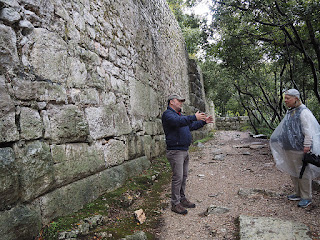BUT, let us not forget Albania for we have literally four to five posts of pictures to still get up....while Rome will be getting further and further behind. AGGGGGGGG.
RUINS
Ancient Ruins
As you may have noted from my past posts, the southern part of Albania was a significant part of the ancient world first under the Illyrian civilization and then as part of the Roman world. Major historical events took place their such as Caesar's defeat of Pompey and the cities were rich and populous. Last Wednesday we visited two archeological sites. One is well known, a UNESCO heritage site called Butrint and the other has barely even been started to be excavated, known as Hadrianopolis.
When we look at these sites, even if the archeologists have done lots of work, you have to take the interpretations with a grain of salt. Imagine someone make a cake, for some reason they are not happy with it and add another whole knew later of batter and bake it again. And this is done three or four times. Then it is forgotten and sits in the refrigerator where it gets pushed to the back and covered with all kinds of other things.
One day you are cleaning out the fridge and you see this. You cut into it and try and figure out what each of the layers were when they were originally made. But they are all squished together and some are missing and pieces of one are found with another. You can make your best interpretation of what happened originally but you are going to never figure out exactly. This is just what happens when they try to interpret some of these sites.
Let's start with Butrint. It was continuously occupied from the Illyrian time through classic Roman, Late Roman, Middle Ages and Venetian times. I am going to show you what is written up here and then discuss some of the problems that we thought of when we went through this.
Here is the story as it is told at the site. Hopefully if you blow these up you can read them
Then there is a line of ruins with explanations of what they were
Basically they have a theater, forum, bath, and line of shops in a linear fashion
The problem is that a Roman town in particular was rarely laid out that way.
You can also see that there differences in the construction materials. The large and smaller stones date to the Illyrian period white the Romans used bricks. Often there is a mish mosh of these like in our cake.
This is supposed to be a bath because of the nature of the floor structure but seems out of place next to the other buildings that are claimed to be in the line.
This is claimed to be a Roman wealthy house
Our guide said the wealthy would never build their home next to the defensive walls as this is. But classic Roman cities deep in the Empire never had walls because there was no danger of attack. The walls came later in the late Roman period or Medieval in my opinion as things got worse.
There is a baptistry that is claimed from the Late Roman
You can't see the mosaics on the floor but our guide says the patterns are not Christian.
Here is a Basilica which clearly is late Roman.
Yet it too has mosaic patterns which date to an earlier period
Speaking of mosaics, these are unusual in that they are on the arches, not commonly found
We had one of those 'experiences' where we ran into three tourists from Italy
Turns out they were from the Salento. One was from Lecce and the other was from a small town right next to the one we stayed at. They were amazed we had been there just the previous week.
We went along to the external walls
This is called the Lion Gate because it shows a lion attaching a bull
Finally we ended up with buildings from the Venetian period
Hadrianopolis is a different case all together
The written explanation is this is a Roman town named after the Emperor Hadrian.
The only problem is the construction type is not Roman but earlier Illyrian. Our guide claimed it to me a town destroyed during the Illyrian Wars when Rome captured this area.
If you look at the size of this theater, and extrapolate how many people could fill it, clearly there must me much more to this city than is currently visible
Well so much for amateur archeology musings for today!


































No comments:
Post a Comment